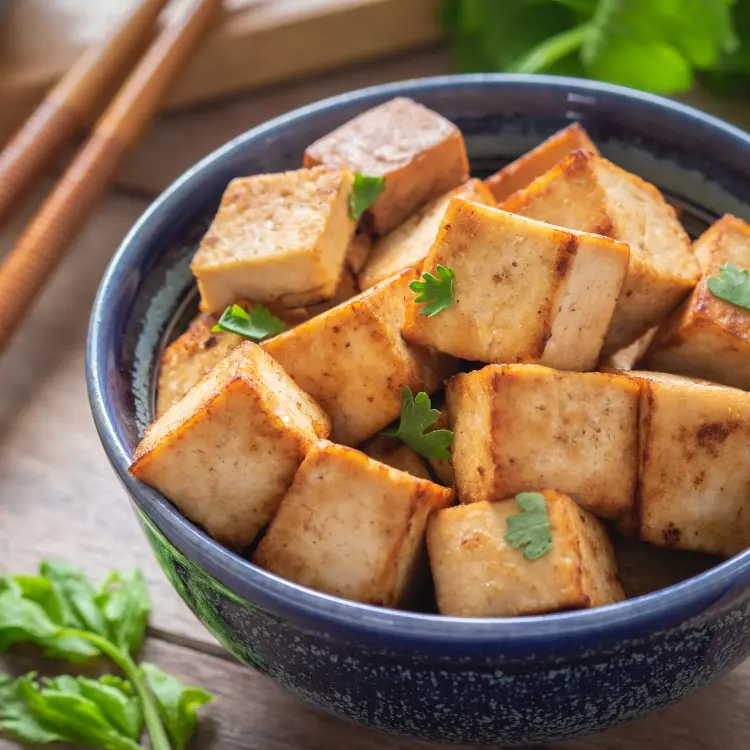What is tofu?
Tofu is a plant-based food made from soybeans, which is high in protein but traditionally low in calories and fat, making it a great vegan alternative to meat.
To mark National Tofu Day, we speak to Laura Kirwan PhD to investigate the environmental impact of tofu and the role it could play in your kitchen in the months ahead.
In this article you’ll learn:
Where does tofu come from?
What does tofu taste like?
How big is the tofu market?
What is tofu made from?
How much protein is in tofu?
Is tofu sustainable?
Is tofu better for the environment than meat farming?
How to introduce tofu into your menu
Where does tofu come from?
The first use of tofu stretches back over 2,000 years ago to the Chinese Han dynasty. Today, it remains a staple in Asian recipes, but its versatility in the kitchen and ability to soak up flavour means it’s often used as a meat alternative in a number of other dishes, from tofu burgers to chicken-style breaded strips.
What does tofu taste like?
As it comes from soy beans, it tastes similar to unsweetened soy milk in its raw form – its spongy texture however soaks up flavours and spices extremely well, making it ideal for marinating before cooking to influence its flavour.
How big is the tofu market?
Tofu is big business and is worth approximately £95m in the UK, with this expected to soar to around £189m in five years’ time (1). Generally used as a replacement for animal products, tofu has found its home on the plates of vegans and vegetarians increasingly in recent years.
What is tofu made from?
Tofu is prepared by coagulating soy milk, with the resulting curds then pressed into blocks of varying softness. As a result, tofu has many forms including puffy tofu, silken, soft, firm and extra firm, all of which have different uses in the kitchen. It all starts with the humble soybean.
How much protein is in tofu?
Half a cup of tofu contains as much as 21.8g of protein (U.S Department of Agriculture), making it a great alternative to meat as a source of protein.
Soybeans are high in protein, amino acids and calcium, meaning that tofu can be a nutritious addition to your menu, and is a great source of alternative protein when used instead of meat. Soybeans are also an excellent source of fibre, providing both soluble and insoluble fibre in excellent quantities, and is therefore a beneficial food to aid bowel movements. You can read more about the nutritional benefits of tofu here.
And is tofu sustainable?
Despite being a plant-based product, tofu has been the centre of some environmental debates in recent years. In 2010, a report conducted on behalf of WWF-UK fanned the embers by highlighting that because most of the raw ingredients for soya-based products had to be imported from overseas, they weren’t a guarantee of lower carbon emissions (2).
Then in 2020, Dr Graham McAuliffe of the Rothamsted Institute caused further headlines by sharing some early-stage findings (which he did flag should be interpreted with caution) at a National Farmers Union conference. He suggested that as the human body finds it harder to absorb protein from plants, people would have to consume these products in higher quantities to get the equivalent amount of animal protein…
“If you look at tofu, which is processed so there is more energy going into its production, […] you can see it could actually have a higher global warming potential than any of the monogastric animals. To get the same amount of protein, tofu is worse,” he said.
There was plenty of backlash to the resulting news stories that were generated following his comments. But it did showcase that like with many food products in our globalised food chain, the question of sustainability is not always a simple answer. The full study was published in 2022 here. The largest gaps in environmental impact research of foods centre around the inclusion of carbon sequestration in life cycle assessment (LCA) calculations, protein digestibility and nutrient bioavailability – and a lack of robust data can make discussions around alternative and animal protein sources difficult to support or contradict.
Over half of the world’s soya comes from Brazil and Argentina, with production in Brazil having quadrupled in just 20 years (3). This growth has come at a cost, with vast areas of forest and natural habitats destroyed for soybean farming.

Is tofu better for the environment than meat farming?
So, another argument thrown at this food (and soya milk) is that its rising popularity contributes to further deforestation, endangering wildlife and ecosystems in the process. However, it’s worth noting that 80% of the world’s soybean crop is fed to livestock, especially for beef, chicken, egg and dairy production (4) – with an estimated 6% used for human consumption (5) – with the rest used for oils.
One conclusion to draw from the above is that while tofu is one product that may be contributing towards deforestation, reducing our meat consumption would be by far the most effective way to reduce the demands on the soy supply chain.
This is backed by a recent study published in the journal Nature Food which found that a vegan diet massively cuts environmental damage, with plant-based diets leading to 75% less climate-heating emissions, water pollution and land use than meat-rich ones. Even moving to a low-meat diet had half the impact of high-meat diets on greenhouse gas emissions, water pollution and land use. The researchers of the study stated that ‘rich nations’ would need to ‘radically’ reduce meat and dairy consumption in order to move towards more sustainable food production.
If the vast majority of soybeans are farmed to feed animals, it shines a light on the inefficiencies of our existing food chain, and therefore limits some of the arguments that are often levied against this food. In addition to this, The Vegan Society have also previously pointed towards a report from the Environmental Working Group which showcases that the greenhouse gas emissions created by 1kg of tofu are far less than that of meats (6).
Introducing tofu to your menu
So, swapping meat for tofu in a recipe can help to lower the carbon footprint and is one way that restaurants and pubs can provide alternative-protein dishes to their menu. Of course, it’s always worth remembering that not all tofu will be sourced and produced in the same way.
Here are five ways that businesses can use tofu to promote more sustainable menu choices:
- Choose organic: Look for products that are certified organic, as they are likely produced without synthetic pesticides and chemicals.
- Support local producers: Buying tofu from local sources where possible can help reduce the environmental impact associated with long-distance transportation.
- Check for certifications: Look for ingredients that hold a claim relating to the Soy Transparency Coalition (STC).
- Sourcing strategy: Question your suppliers and review their sourcing policy, and ask for 100% sourcing from verified deforestation and conversion free sourcing areas
- Packaging: Think about how the product arrives, and how you can responsibly recycle any packaging after use.
Final thoughts
Like any food, tofu’s sustainability depends on the production methods and supply chain involved, but when created using environmentally friendly practices and sourced responsibly, tofu can certainly be considered a sustainable food option for your menu. Menu design should always focus around data, and changes to menus and reformulating dishes should not be made until the impact on the environment and nutrition are reviewed. This should be easily done using your menu management system.
If you’re looking for advice on sustainability in your business, get in touch with the Knowledge Labs team today. Knowledge Labs provides Hospitality and Food Service (HaFS) operators with expert advice and support across a range of topics central to their ESG strategy, including food related sustainability, nutrition, employee wellbeing, and compliance.
References:
- Mordor Intelligence, 2023
- How Low Can We Go – WWF-UK, 2010
- Greenpeace, 2023
- WWF, 2023.
- Scarborough, P., Appleby, P. N., Mizdrak, A., Briggs, A. D. M., Travis, R. C., Bradbury, K. E., & Key, T. J. (2014, June 11). Dietary greenhouse gas emissions of meat-eaters, fish-eaters, vegetarians and vegans in the UK. NCBI. Retrieved December 2, 2022, from https://www.ncbi.nlm.nih.gov/pmc/articles/PMC4372775/
- https://static.ewg.org/reports/2011/meateaters/pdf/methodology_ewg_meat_eaters_guide_to_health_and_climate_2011.pdf
What should you do now
Here are three ways we can help you learn more about the ways you can use food data to grow your business and revenue:
- Book a free demo. Our product expert will find out a little more about the challenges you’re facing and how we can help.
- Try us for free. Get a 7-day free trial of Nutritics to see how easy it is to get started on saving time and money.
- If you’d like to learn more about our experts and insights, take a look at our blog where we break down recipes, provide the latest industry advice and go in-depth in our reports.
